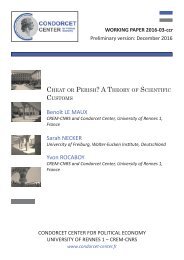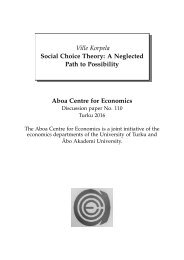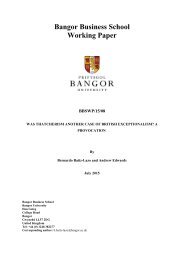MEMORANDUM
n?u=RePEc:hhs:osloec:2016_018&r=hpe
n?u=RePEc:hhs:osloec:2016_018&r=hpe
You also want an ePaper? Increase the reach of your titles
YUMPU automatically turns print PDFs into web optimized ePapers that Google loves.
Others have touched upon the question of when and where Leontief arrived at his<br />
input-output approach.<br />
An account given by Ann Carter, a close associate of Leontief over many years from<br />
the late 1940s is the following:<br />
“When Wassily Leontief first came to the United States, he spent a year or so in<br />
New York working at the National Bureau for Economic Research. He was<br />
developing a new system, later to be called input- output analysis. One day he<br />
received an invitation to join the Harvard faculty. He replied with qualified interest:<br />
he would be pleased to come, but he required a grant of $1500 to cover the cost of a<br />
research assistant to help him with the implementation of his fundamental new<br />
study. They reviewed his project with considerable skepticism. What he proposed<br />
to do was probably impossible and certainly very strange. Still, they seemed to want<br />
him. The $1500 was granted on condition that he agree ‘to report his failure in<br />
writing’ at the end of the year.” (Carter 1976, p.57).<br />
Another long-time Leontief associate, Karen Polenske, places the origin slightly<br />
further back in time: “Leontief indicated that his development of the input-output model of<br />
an economy was influenced by Quesnay and Walras, not Marx, and that he conceived of<br />
the input-output structure in 1927 at the Institute for World Economics in Kiel” (Polenske<br />
2004, p.11). Others have pointed to Leontief’s doctoral dissertation Wirtschaft als<br />
Kreislauf as the origin of his input-output approach.<br />
In the autobiographical note provided for his Nobel award in 1973 Leontief gave a<br />
brief account of the scientific logic in the path he followed:<br />
“Having come to the conclusion that so-called partial analysis cannot provide a<br />
sufficiently broad basis for fundamental understanding of the structure and<br />
operation of economic systems, I set out in 1931 to formulate a general equilibrium<br />
theory capable of empirical implementation.” (Leontief 2015).<br />
This paper thus aims at following the tracks from Leontief’s early life in St. Petersburg<br />
via Berlin, Kiel, New York to Harvard and in that biographical context look at how it<br />
happened that Wassily Leontief arrived at his input-output formulation. There is no<br />
comprehensive biography of Leontief but he spoke freely, often and with many about his<br />
life and experiences. In later years he gave interviews with fascinating details about his<br />
experiences.<br />
While always prepared to speak on his scholarly work and contribute his view on a<br />
wide range of current issues Leontief was reticent about being elevated and presented as an<br />
important personality in the field of economics. Invited in 1988 to contribute a chapter on<br />
3





